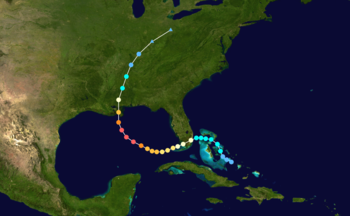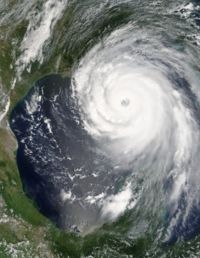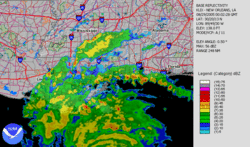Meteorological history of Hurricane Katrina
2007 Schools Wikipedia Selection. Related subjects: Natural Disasters
| Hurricane Katrina |
|
 |
|
|
General
Impact
Relief
Analysis
Other wikis
|
|
The meteorological history of Hurricane Katrina, an extremely destructive Category 5 hurricane, began on August 23, 2005 when it originated as Tropical Depression Twelve near the Bahamas. The next day, the tropical depression strengthened to a tropical storm, receiving the name Katrina; then, it proceeded to make landfall on southern Florida as a minimal hurricane.
After passing through Florida, Katrina weakened back to a tropical storm; however, the warm waters of the Gulf of Mexico allowed it to rapidly intensify to the sixth strongest Atlantic hurricane in history. Afterwards, Katrina made landfall as a Category 3 storm near Buras-Triumph, Louisiana, and once more near the Mississippi/ Louisiana border.
Following its landfall, Katrina progressed up through the central United States and finally dissipated near the Great Lakes, when it was absorbed by a cold front.
Formation
Tropical Depression Twelve formed over the southeastern Bahamas at 5:00 p.m. EDT (2100 UTC) on August 23, 2005, partially from the remains of Tropical Depression Ten, which had dissipated due to the effects of a nearby upper tropospheric trough. While the normal standards for numbering tropical depressions in the Atlantic indicate that the old name/number is retained when a depression dissipates and regenerates, satellite data indicated that a second tropical wave combined with Tropical Depression Ten north of Puerto Rico to form a new system, which was then designated as Tropical Depression Twelve. Simultaneously, the trough in the upper troposphere weakened, causing the wind shear in the area to relax, thereby allowing the new tropical depression to develop. In a later re-analysis, it was determined that the low-level circulation of Ten had completely detached and dissipated, with only the remnant mid-level circulation moving on and merging with the aforementioned second tropical wave. As a result, the criteria for keeping the same name and identity were not met.
First landfall
As the atmospheric conditions surrounding Tropical Depression Twelve were favorable for tropical development, the system began to intensify and was upgraded to Tropical Storm Katrina on the morning of August 24. A burst of convection allowed Katrina to become the fourth hurricane of the 2005 season on August 25, only two hours before it made landfall around 6:30 p.m. EST (2230 UTC) between Hallandale Beach and Aventura, Florida. Katrina struck the peninsula with 80 mph (130 km/h) winds, and had a well-defined eye on Doppler radar, which remained intact throughout its passage over Florida. The storm weakened over land on August 26 to a tropical storm, but regained strength to hurricane status at 2:00 a.m. EDT (0600 UTC), approximately one hour after ending its passage through Florida and entering the Gulf of Mexico. Parts of the Florida Keys experienced tropical storm winds throughout August 26, with the Dry Tortugas briefly experiencing hurricane-force winds.
Gulf of Mexico
The initial National Hurricane Centre forecasts predicted that Katrina would begin turning northward after landfall, eventually to hit the Florida Panhandle approximately three to four days later. Katrina, however, continued a westerly and west-southwesterly track, which eventually shifted the forecast track westward to New Orleans.
Immediately after the storm entered the Gulf of Mexico, the low wind shear, good upper-level outflow, and the warm sea surface temperatures of the Gulf Loop Current caused Katrina to intensify rapidly. On August 27, the storm was upgraded to Category 3 intensity, becoming the third major hurricane of the season. An eyewall replacement cycle disrupted the intensification of maximum winds for about 18 hours, but almost doubled the radius of the storm. A second period of rapid intensification started by 7:00 p.m. CDT on August 27, and by 12:40 a.m. CDT on August 28, Katrina was upgraded to a Category 4 hurricane with maximum sustained winds of 145 mph (233 km/h). It became a Category 5 storm by 7:00 a.m. CDT, twelve hours after the beginning of the second round of rapid intensification, and reached its peak intensity at 1:00 p.m. CDT with maximum sustained winds of 175 mph (280 km/h), gusts of 215 mph (344 km/h) and a central pressure of 902 mbar (26.64 inHg). The minimum pressure made Katrina, at the time, the fourth most intense Atlantic hurricane on record (Hurricanes Rita and Wilma would later surpass Katrina that same year).
By the afternoon of August 28, the storm was large enough that some areas of the Gulf Coast were already experiencing tropical storm-force winds. The centre of Katrina was about 180 statute miles (290 km) from the mouth of the Mississippi River, but tropical storm-force winds extended 230 mi (370 km) from the centre of the storm, and hurricane-force winds extended about 105 miles (170 km) away. Overnight on August 29, and into the morning of the next day, Katrina quickly weakened (in terms of maximum sustained winds) as it began to enter another eyewall replacement cycle. The inner eyewall deteriorated before an outer eyewall had fully formed, playing an important role in the weakening. In 18 hours, the hurricane's maximum sustained winds decreased from 170 mph (280 km/h) to 125 mph (205 km/h). However, storm surge remained high at landfall because large waves greater than 30 ft (9.1 m) in height were generated beforehand (with a buoy recording a 55 ft/16.7 m wave at sea), when Katrina was at Categories 4 and 5 in the Saffir-Simpson Hurricane Scale. The waves then combined with the storm surge of the large Category 3 hurricane.
Second and third landfalls
Katrina made its second landfall at 6:10 a.m. CDT on August 29 as a Category 3 hurricane with sustained winds of 125 mph (205 km/h) near Buras-Triumph, Louisiana. At landfall, hurricane-force winds extended 120 miles (190 km) and the storm's central pressure was 920 mbar (27.17 inHg). Because Katrina had just weakened from Category 4 and due to the shape of the coastline, sustained Category 4 winds likely existed on land while the eye was over water. At landfall, hurricane-force winds extended 120 miles (190 km) from the centre, the storm's pressure was 920 mbar (27.17 inHg), and its forward speed was 15 mph (10 km/h). Making its way up the eastern Louisiana coastline, most communities in Plaquemines, St. Bernard Parish, and Slidell in St. Tammany Parish were severely damaged by storm surge and the strong winds of the eyewall, which also grazed eastern New Orleans.
Original estimates indicated that Katrina had made this landfall as a Category 4 hurricane, with 135 mph (220 km/h) winds; however, as indicated above, the storm weakened just before landfall to Category 3 intensity. The reasons behind this weakening are not completely known yet; while the eyewall replacement cycle played a part, slightly-increasing shear, dropping sea surface temperatures, dry air on the western semicircle of the storm and interaction with the continental landmass also may have played a role in weakening the cyclone. This follows the trend of previous strong cyclones in the Gulf of Mexico: all cyclones with minimum central pressures of 973 mbar (28.73 inHg) or less have weakened in the last 12 hours before making landfall in the Gulf Coast of the United States.
A few hours later, after weakening slightly, Katrina made its third landfall near the Louisiana/Mississippi border with 120 mph (195 km/h) sustained winds and 928 mbar (27.37 inHg) pressure, still at Category 3 intensity. Its minimum pressures at its second landfall was 920 mbar (27.17 inHg), making Katrina the third strongest hurricane on record to make landfall on the United States, behind Hurricane Camille's 909 mbar (26.85 inHg) reading in 1969, and the 1935 Labor Day Hurricane's 892 mbar (26.35 inHg) record.
Because the storm was so large, extremely-damaging eyewall winds and the strong northeastern quadrant of the storm pushed record storm surges onshore, smashing the entire Mississippi Gulf Coast, including towns in Mississippi such as Waveland, Bay St. Louis, Pass Christian, Long Beach, Gulfport, Biloxi, Ocean Springs, Gautier and Pascagoula, and, in Alabama, Bayou La Batre. The surges peaked at 28 ft (8.5 m) in Bay St. Louis, Mississippi, and at 13 ft (4.0 m) as far away as Mobile, Alabama, which saw its highest storm surge since 1917. Storm surge was particularly high due to the hydrology of the region, the hurricane's extreme size, and the fact that it weakened only shortly before landfall. As Katrina moved inland diagonally over Mississippi, high winds cut a swath of damage that affected almost the entire state.
Demise
Katrina maintained hurricane strength well into Mississippi, but weakened thereafter, losing hurricane strength more than 150 mi (240 km) inland, near Meridian, Mississippi. It was downgraded to a tropical depression near Clarksville, Tennessee and broke in half. One half continued to race northward, affecting the Central United States along its path, and was last distinguishable in the eastern Great Lakes region on August 31. On August 31, Katrina was absorbed by a frontal boundary and became a powerful extratropical low, causing 1.97-6.69 in (50-170 mm) of rain in 12 hours, as well as gale-force wind gusts from 31 to 61 mph (50 to 98 km/h) in southeastern Quebec and northern New Brunswick. In the region of Saguenay and Cote-Nord, rain caused breakdowns and failure in roads. The Cote-Nord region was isolated from rest of Quebec for at least 1 week. The other half of Katrina broke off in the eastern part of the Appalachians, primarily leading to a significant tornado outbreak in the area from central Georgia to central Pennsylvania, killing two people and causing millions of dollars in additional damage.
At 11:00 p.m. EDT on August 31, the centre of the remnant low of what was Katrina had been completely absorbed by a frontal boundary in southeastern Canada, with no discernible circulation.





